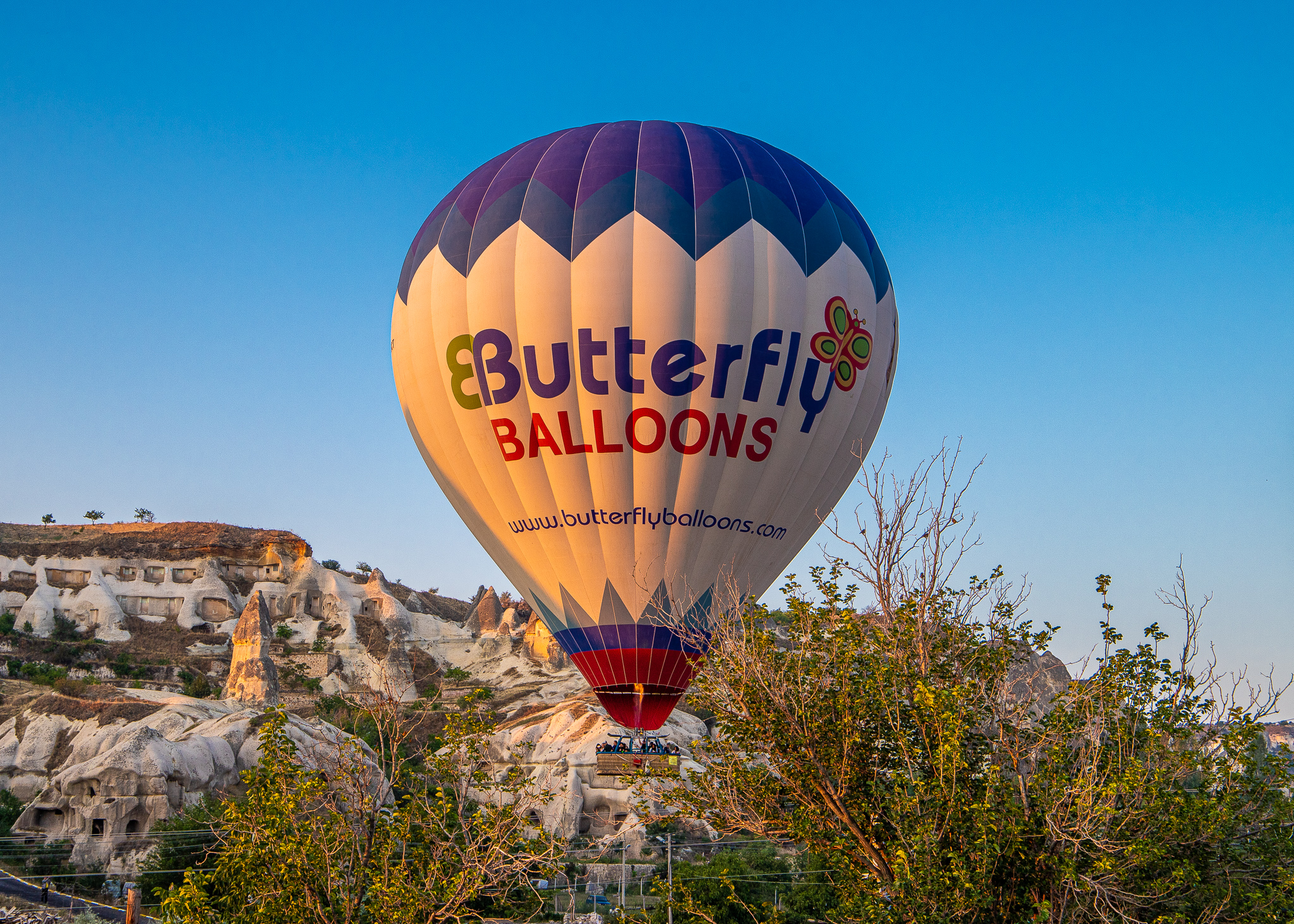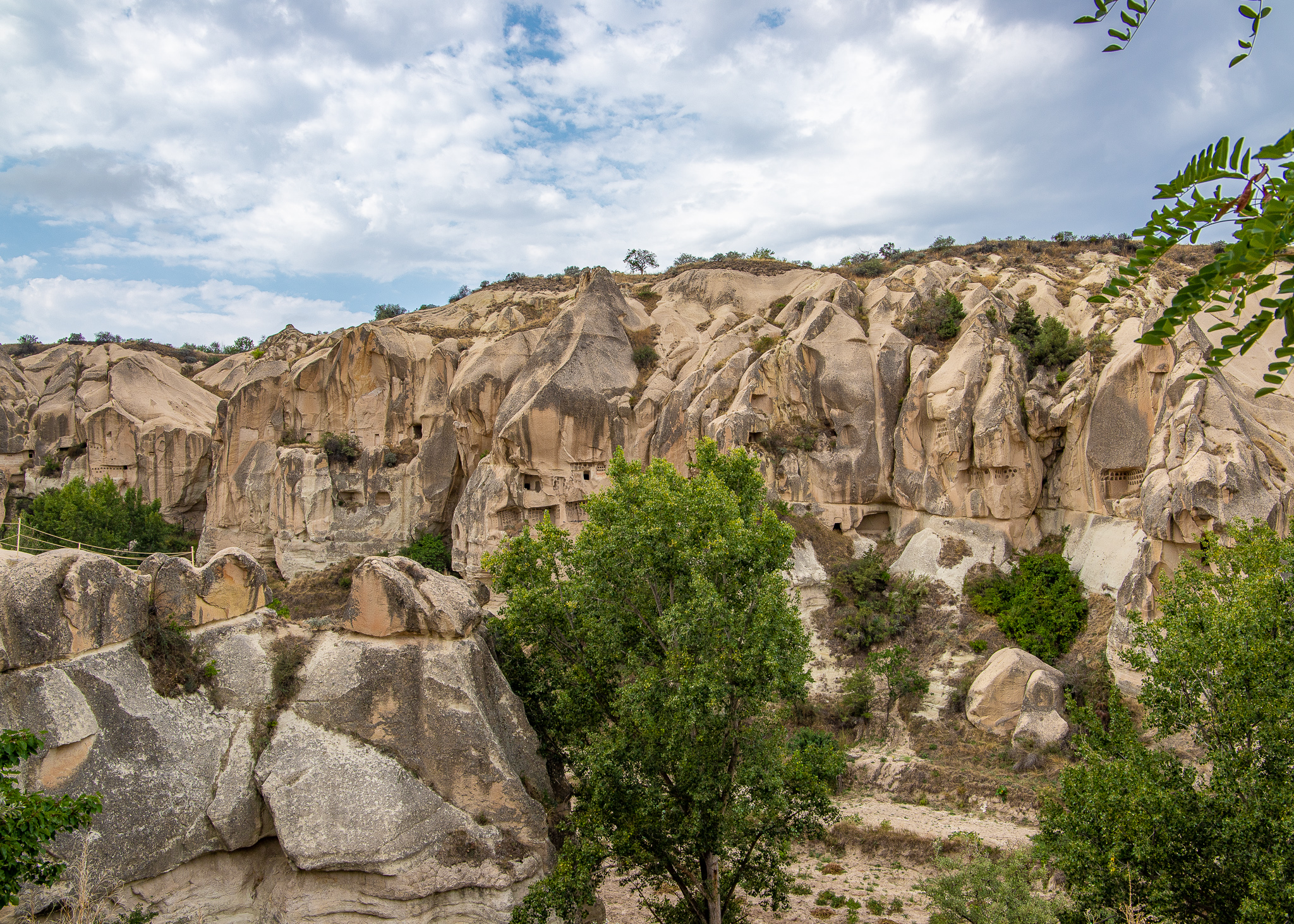Landing in the small town of Goreme in Cappadocia, it seems like we’ve been transported to another world. We opted for the easier route of flying into Nevesehir 35 minutes from Goreme via Istanbul which gave us an opportunity to see some of the natural rock formations that this part of Turkey is famous for, in particular its “fairy chimneys”, on the drive in. With a population of around 2,000, tourists seem to outnumber residents and the town is easily covered in 10 minutes walking from one end to the other which will take you past a plethora of restaurants, guesthouses, tourism offices, supermarkets selling mostly water, beer, chips and cigarettes and carpet shops.
We’ve elected to stay in a cave house which are common throughout the entire town with rooms having been created by cutting directly into the soft sandstone (tufa). We’ve also splurged out a bit and gone for a pool option given the beautifully consistent and warm temperatures at this time of year.
0 Holiday Cave Hotel
Being on the “outskirts” of town means there’s nothing between us and the rock formations and trails that lead away from the town which provides killer views. With its laid back nature, this is definitely a place we could get used to.
Girls squinting obligingly into the sun
For most people, Goreme is equated with hot air ballooning. Every morning up to 100 balloons take to the air providing tourists with amazing views of the valleys around Cappadocia. A lot of the balloons purposely drift directly over Goreme providing those staying in the town with a good excuse to get out of bed to view the spectacular show from front row seats.
It’s hard to explain just how amazing the balloon show is, but suffice to say that of the six mornings that we were in Goreme, I got out of bed each day to watch them.
But we haven’t come here solely for the balloons. Situated just one kilometre from Goreme town is the UNESCO World Heritage listed Goreme Open-Air Musuem. The walk to the Museum is pleasant enough and enables you to pass a couple of picture worthy sights, as well as some pottery shops, if you’re into that kind of thing.
Heading towards the Goreme Open Air Museum
Entrance fee into the Open Air Musuem is 54 TL per person (about NZ$15) for everyone aged over 8 years. Additionally, you can rent an audio guide which provides a modicum of information for a further 25 TL per headset.
The Museum consists of a wide range of monasteries, churches and houses that have been carved into the rock and which date back to the 4th century AD. These early Christian sanctuaries contain excellent examples of Byzantine art and colourful frescoes, the best of which are contained within the Dark Church, which costs an additional 18 TL. It is probably at about this point that you start to realise that you’re starting to be taken advantage of, as why it couldn’t all be included in the same ticket prices is beyond me.
To be honest, a trip to the “museum” is a bit of a mixed bag. It’s easy accessibility means that plenty of tourists descend on the site, of which 99% seem more interested in taking selfies rather than taking in any historical information. This makes getting any decent photos, where you are allowed to take them that is, problematic.
Church with Apple
View out to Dark Church, Refectory and Church with Snake
Church of the Sandals
However, with a bit of patience, angles and creativity it is possible to snap off the odd photo that doesn’t make the Museum site look like an oversized sardine can. Whilst it’s best to adhere to the usual come first thing or last thing, even at these times don’t expect to have the place to yourself.
Views away from the Churches of Goreme
View down the the Nun’s Convent, which was closed when we visited
Same view out to Dark Church, Refectory and Church with Snake when the crowds had dissipated a bit
Due to flash photography damaging the delicate nature of the frescoes within the church, no photos are allowed to be taken inside. Unfortunately, I didn’t see the sign stating this and took a few photos inside the first church before exiting and seeing the very prominant sign stating no photography. Doh! Given I never use flash photography due to being aware of the damage it can do (as well as not having a flash on my big camera), no harm was done, but it is annoying that as a result of people not having the nous to realise that they need to turn off their flash, these days no one is allowed to take photos of the lovely frescoes inside.
Grave inside Chapel of St Basil
Frescoes inside St Basil Church
Mary and Baby Jesus
Outside the main site of the Churches of Goreme is what, for me, was the highlight. Having exited and gone through the turnstile the Broken (Tokali) Church is about 50 metres back down the road towards Goreme on the right hand side. You have to show your ticket to gain admittance to the four churches in this part of the museum: The Old Church, the New Church the Lower Church under the Old Church and the Parecclesion. The Old Church and the New Church are particularly striking with the latter displaying the story of Jesus in chronological order in bright red and blue colours. This dark blue colour differentiates the Tokali Church from all the other churches and makes it well worth seeing (even if you can’t take photos!). Just make sure you don’t hand in your audio guide before checking out this church (although it will necessitate going back up the road once again to hand it in in order to get your ID back).
Despite the high entrance fee, loads of tourists and inability to take photos of the frescoes, the site is still worth visiting. The kids remained semi interested so long as they had the audio guide, although after a while the churches tended to blend into one another. All up we spent 1 and a half hours there and given the heat were thankful for having brought plenty of water.
The small town of Uchisar is also definitely worth checking out with its magnificient citadel, which can be seen from miles away.
Uchisar Citadel
It’s only ten minutes by minibus (dolmus) to the adjacent town of Uchisar which is situated at the highest point in Cappadocia. Or, you can the less than five kilometres along Pigeon Valley which was directly behind our accommodation. After getting off the dolmus, it’s a short slight uphill walk to Uchisar Castle before ascending a moderate amount of stairs to get to the top of the citadel.
Uchisar Castle
Whilst the citadel itself doesn’t have a whole lot to see, the 360 degree views from the top are what makes the climb worthwhile.
View back to Goreme
Pigeon Valley
View down to Uchisar town and Goreme off in the distance
Looking out to Love Valley with the towns of Cavusin to the top right and Avanos further off in the top left
With stunning views like that, I had all the motivation I needed in order to check out some of the amazing valleys that Capaddocia has to offer.

























